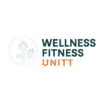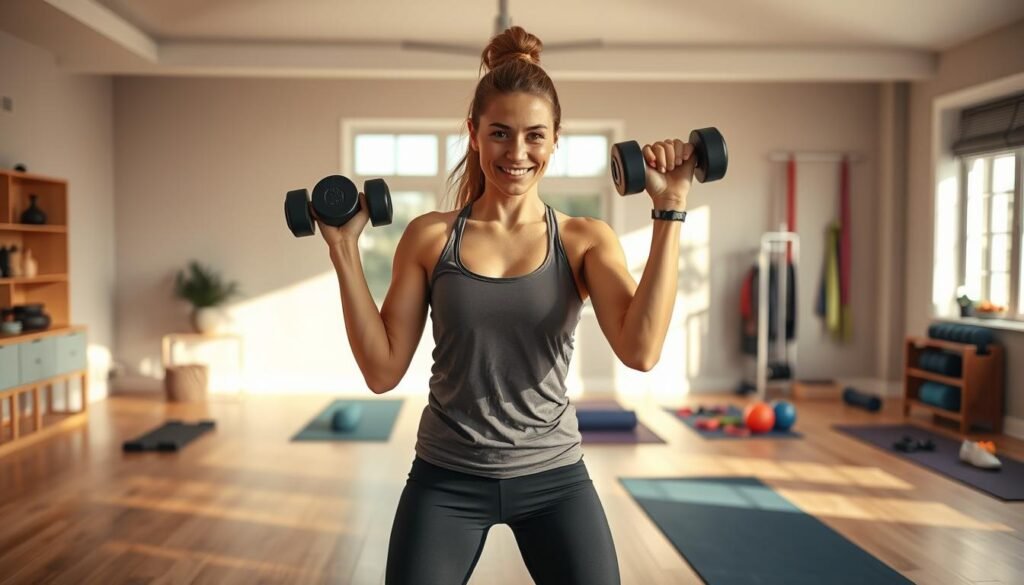You don’t need a gym to get fit. Smart planning and bodyweight exercises can help you build strength and endurance at home. The key is to create structured sessions that work on many muscle groups and keep things interesting.
Studies show that just 20 minutes of daily movement can make a big difference. Try mixing push-ups with lunges or planks with squat jumps. These combos boost your metabolism and improve coordination. Adding simple tools like resistance bands or dumbbells can make workouts more intense without taking up too much space.
This method uses proven movement patterns like push, pull, hinge, squat, and carry. By switching between these, you’ll stay balanced and avoid getting stuck in a rut. Plus, you can set your own pace. Rest when you need to, and push harder when you’re ready.
Key Takeaways
- 20-minute sessions deliver efficient results through strategic exercise pairing
- Bodyweight movements require zero equipment while building functional strength
- Combining push/pull/hinge patterns prevents workout boredom
- Portable gear like resistance bands adds variety without space demands
- Daily consistency matters more than marathon weekend sessions
Understanding the Benefits of Home Workout Routines
Turning your home into a gym offers more than just saving time. You can do at home exercises during lunch or create a full-body routine. These workouts fit into your life, not the other way around.
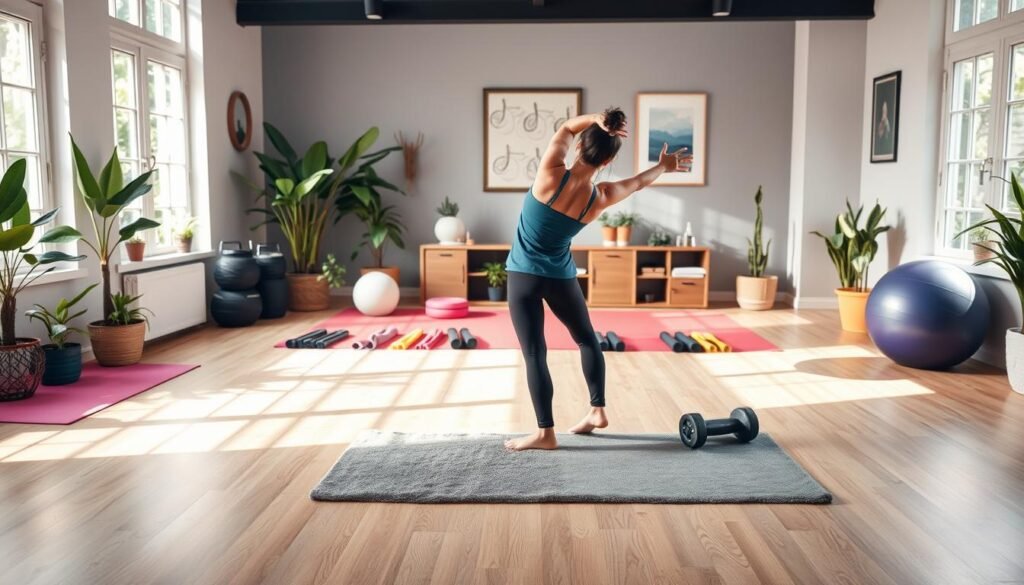
Convenience and Flexibility
No need to travel or deal with crowded gyms. Your living room is your gym whenever you want. Studies show home workouts remove 72% of gym attendance barriers. As one study notes:
“Bodyweight exercises can be done anywhere, making it easy for busy people to stay consistent.”
You set the schedule. Want to do yoga in the morning or strength training at midnight? No problem. Missed your workout time? Do a quick 10-minute core workout later.
Cost-Effective Options
No need for expensive gym memberships. Most stay at home fitness plans need little equipment:
- Resistance bands ($10-$30)
- Yoga mat ($20)
- Water bottles as light weights
Free online resources replace the need for personal trainers. Use YouTube or apps for guided workouts. Over a year, this saves the average American $800+ compared to gym costs.
Customized Fitness Experience
Make every workout your own. Don’t like burpees? Try mountain climbers instead. Have knee pain? Modify squats to chair-assisted versions. This personal touch leads to:
- Higher workout satisfaction
- Reduced injury risk
- Faster progress toward goals
Change the intensity daily based on how you feel. Some days do power yoga, others high-energy dance workouts. All without judgment from others.
Essential Equipment for Home Workouts
Creating a home gym doesn’t have to be expensive or take up too much space. You can choose between no equipment workouts or pick versatile tools. This way, you can get great results without cluttering your home. Let’s explore how to pick the right gear for your fitness level, space, and budget.

Choosing the Right Gear
First, think about what kind of workouts you like. Do you focus on strength, cardio, or flexibility? Adjustable dumbbells are a great choice for home gym routines. They save space and are versatile.
Resistance bands are also a good option. They’re light, easy to carry, and work for many exercises like rows, squats, or shoulder presses.
Must-Have Fitness Tools
These three items are essential for most workouts:
- Yoga mat: It protects your joints during floor exercises and is great for stretching
- Stability ball: It helps strengthen your core in planks, bridges, or seated exercises
- Jump rope: It’s a quick way to get a great cardio workout in under 5 minutes
For recovery, consider wearing cushioned training shoes. They help reduce joint impact during high-intensity workouts.
Budget-Friendly Alternatives
Turn everyday items into workout gear:
- Use filled water bottles as light weights for lateral raises
- Replace sliders with hand towels on hardwood floors
- Turn stairs into cardio machines with step-up routines
Many no equipment workouts are just as effective as gym sessions. Push-ups, lunges, and plank variations are great for building strength. They’re perfect for small spaces or if you’re on a tight budget.
Designing Your Home Workout Plan
Turning your home into a fitness zone is powerful. It helps you build muscle, get more endurance, or stretch better. A good indoor workout plan keeps you on track and consistent. Here’s how to make a routine that fits your life and gets results.
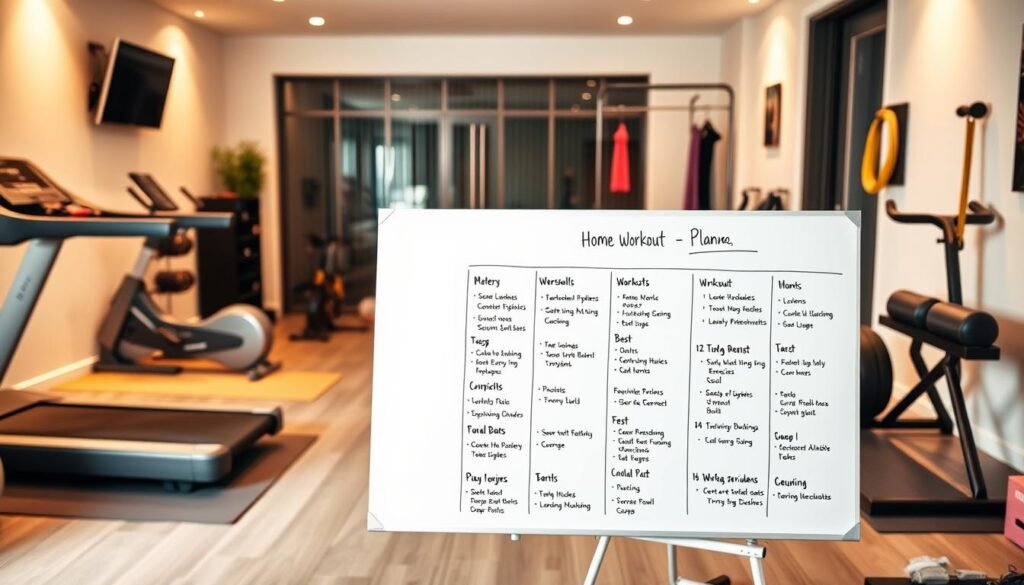
Setting Realistic Fitness Goals
Begin with clear, achievable goals. Use the SMART method for this. Instead of saying “get fit,” aim for “do 15 push-ups in one go” or “hold a plank for 60 seconds.” Keep track of your progress each week with a journal or app. Small wins help you stay motivated and avoid getting tired.
Structuring Your Weekly Schedule
A good plan is to work out 3 times a week. Here’s what it could look like:
- Day 1: Focus on upper body (push-ups, rows)
- Day 3: Work on lower body (squats, lunges)
- Day 5: Do full-body cardio (burpees, mountain climbers)
Remember, rest days are important for recovery. You can adjust the schedule to fit your morning or evening routine.
Balancing Strength, Cardio, and Flexibility
Change up your workouts to avoid getting stuck. Mix strength exercises like dumbbell presses with short cardio bursts, like jump rope. Set aside one day a week for yoga or stretching. This mix boosts metabolism, builds muscle, and lowers injury risk.
Total-Body Strength Training Routines
Building strength at home starts with basic moves and gets harder as you get better. These routines are great for beginners or those looking to improve. They help you grow stronger while keeping your muscles challenged.
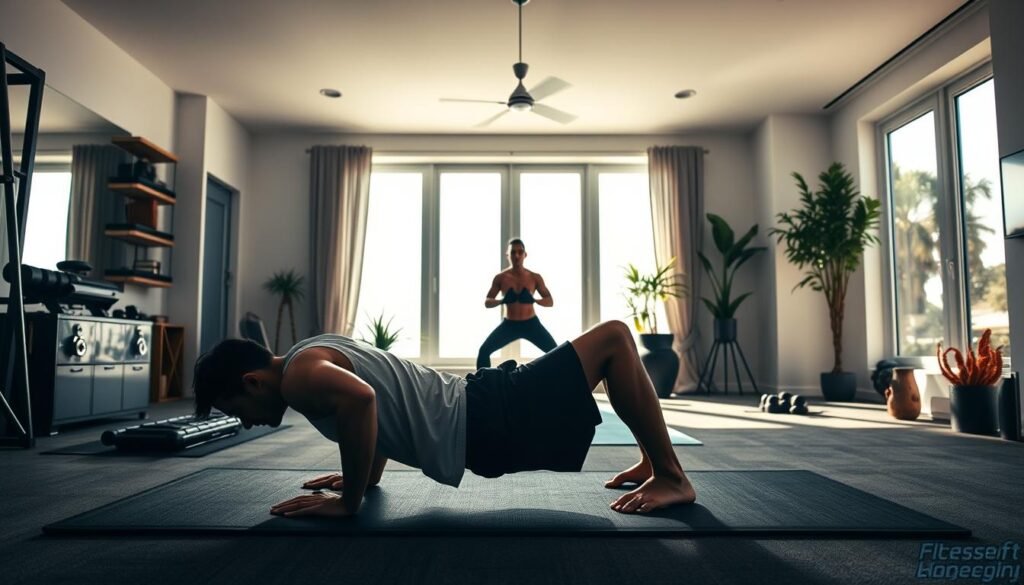
Bodyweight Exercises for Beginners
Learn these basic moves first, before using any equipment. Use Source 1’s tips to keep your form right:
- Pushups (keep elbows at 45° to protect shoulders)
- Bodyweight squats (track knees over toes)
- Plank-to-downward dog flows (engage core throughout)
- Glute bridges (squeeze at the top for 2 seconds)
- Bulgarian split squats (use a sturdy chair for balance)
Start with 3 sets of 8-12 reps, resting 90 seconds between sets. For squats, “imagine sitting back into an invisible chair” to keep your hips right.
Intermediate Weight Training Options
When basic moves are easy, add resistance with household items or dumbbells. Try these Source 2-approved exercises:
- Goblet squats (hold a gallon water jug close to chest)
- Single-arm dumbbell rows (use a backpack filled with books)
- Overhead press with resistance bands (anchor under feet)
- Weighted hip thrusts (place weights on your lap)
Alternate between upper and lower body workouts for better recovery. Source 1 suggests combining big lifts like squats with core exercises for effective workouts.
Advanced Strength Challenges
Try these tough exercises to push your limits:
- Plyometric pushups into shoulder taps
- Single-leg deadlifts holding weights
- Weighted step-ups with knee drive
- Lateral lunges with overhead press
Source 2 stresses controlled eccentric movements – aim for 3-second descents in squats. Always warm up with dynamic stretches to avoid injuries during these tough workouts.
Cardiovascular Workouts for Home
You don’t need fancy machines or gym memberships to boost your heart rate at home. With a little creativity and minimal gear, you can create cardio sessions that burn calories and improve endurance. Let’s dive into three fun ways to keep your home fitness workouts exciting and effective.
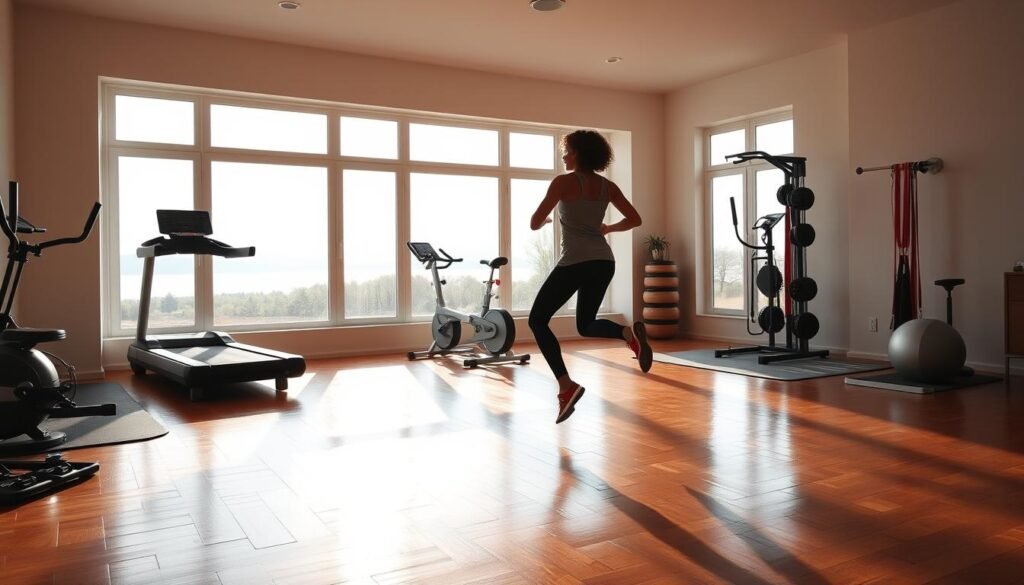
High-Intensity Interval Training (HIIT)
HIIT mixes short, intense efforts with rest periods. It’s perfect for those with busy schedules. A 20-minute HIIT session might include 30 seconds of squat jumps, mountain climbers, or bicycle crunches, followed by 15 seconds of rest. This method keeps your metabolism high for hours after, studies show.
Pro tip: Adjust the intensity by changing the work-to-rest ratio. Beginners might start with 1:2 intervals (20 seconds work, 40 seconds rest). More experienced exercisers can aim for 2:1 ratios.
Jump Rope Workouts
Jumping rope is a childhood favorite that’s great for cardio. Research shows 10 minutes of jumping is like 30 minutes of jogging. Start with basic bounces, then try alternating feet or double-unders. Use a weighted rope for more challenge or a lightweight one for speed.
- Warm-up: 2 minutes steady skipping
- Intervals: 45 seconds fast pace, 15 seconds rest (repeat 8x)
- Cool-down: 1 minute slow skips with arm circles
Dance-Based Fitness Classes
Transform your living room into a dance studio with online Zumba, hip-hop, or cardio dance classes. These workouts make exercise fun while improving coordination and stamina. YouTube and fitness apps offer routines from 15-minute energizers to 45-minute full sessions.
For small spaces, focus on low-impact moves like salsa steps or body isolations. Use wireless headphones to get lost in the music without disturbing others.
Incorporating Flexibility and Recovery
Your home gym routines need time for flexibility and recovery. These steps prevent injuries, boost performance, and keep you moving forward. Here are some easy ways to add them to your fitness plan.
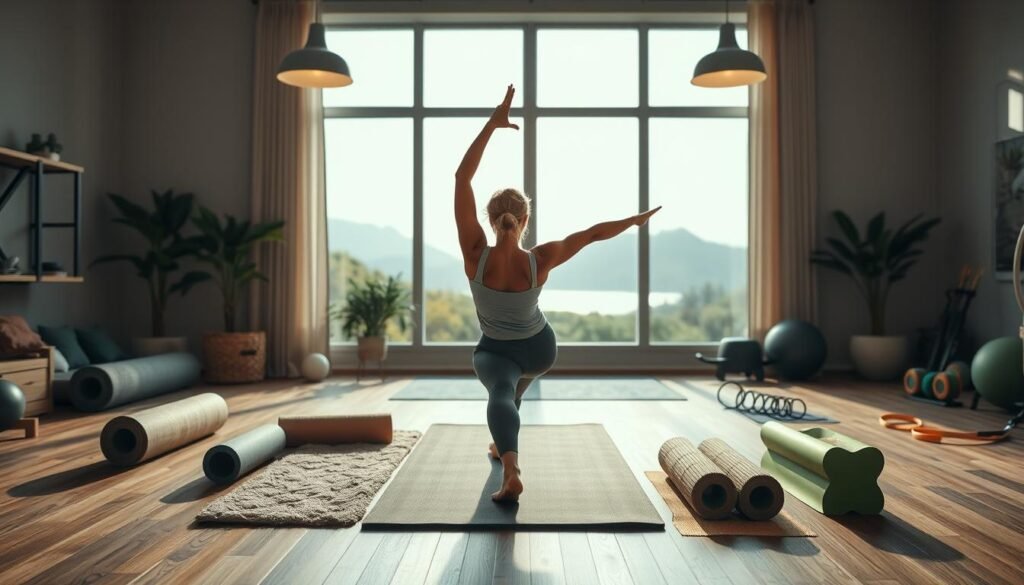
Importance of Stretching
Stretching is more than just cooling down. It’s crucial for muscle health. Begin with dynamic stretches like leg swings or arm circles before working out. Then, do static stretches like hamstring or chest openers after. Just 10 minutes a day can improve joint mobility and lessen soreness.
Yoga and Pilates at Home
Turn your living room into a yoga or Pilates space. These activities strengthen your core and relax you. Try these simple moves:
- Cat-Cow stretches for spinal flexibility
- Plank-to-Downward Dog transitions
- Pilates hundreds for abdominal engagement
For more active options, check out mobility exercises that go well with strength training.
Foam Rolling Techniques
Your foam roller is a great tool for muscle recovery. Use it on these areas:
- Quads: Roll slowly from hip to knee
- Upper Back: Support your head and arch over the roller
- Calves: Cross one leg over the other for deeper pressure
Focus on sore spots for 30 seconds – breathe through it. Mix this with light cardio on rest days for active recovery. This keeps your home gym routines going strong.
The Role of Nutrition in Your Home Workout Success
Your stay at home fitness routine isn’t complete without proper nutrition. What you eat fuels your energy, repairs muscles, and determines whether you hit your goals or plateau. Even small dietary adjustments can amplify results, especially when paired with smart meal timing and hydration habits.

Meal Planning for Fitness
Planning meals ensures you’re eating to support workouts, not sabotage them. Focus on balanced meals with lean proteins (chicken, tofu), complex carbs (oats, quinoa), and healthy fats (avocado, nuts). For example, a post-workout meal rich in protein and carbs helps rebuild muscle and replenish energy stores.
| Nutrient | Pre-Workout | Post-Workout |
|---|---|---|
| Carbohydrates | 1–2 hours before (oatmeal, banana) | Within 45 minutes (sweet potato, brown rice) |
| Protein | Optional (Greek yogurt) | 20–30g (chicken, protein shake) |
| Fats | Avoid heavy fats | Add modest portions (almonds, olive oil) |
For more meal planning strategies, focus on portion control and weekly prep. Batch-cook proteins and veggies to save time while staying consistent.
Hydration Tips
Dehydration reduces performance by up to 30%. Drink 16–20 oz of water 2 hours before exercising, and sip 7–10 oz every 10–20 minutes during workouts. Add electrolytes after intense sessions to replace lost minerals.
- Carry a reusable water bottle
- Flavor water with lemon or cucumber
- Avoid sugary sports drinks unless training >90 minutes
Supplements to Consider
While whole foods should come first, these supplements can fill gaps:
- Whey protein: Supports muscle recovery
- Creatine: Boosts strength during high-intensity workouts
- Omega-3s: Reduces inflammation
Always consult a healthcare provider before adding new supplements, especially if you have dietary restrictions.
Staying Motivated During Your Home Workouts
Being consistent is key to successful indoor workout plans. But, it’s not always easy. Here are three proven ways to keep going and celebrate your achievements.
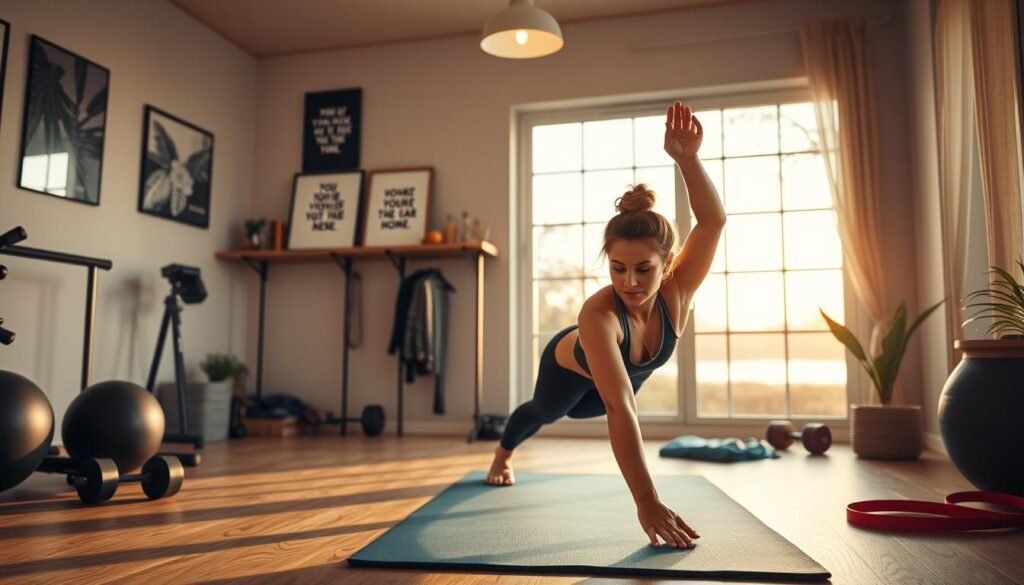
Break Goals Into Bite-Sized Wins
Tracking your progress each week can make a big difference. Try setting smaller goals:
- Start with easy targets (like “15 push-ups daily”)
- Reduce the number of reps by 20% each week to get stronger
- Mark your achievements with non-food rewards
A 2023 study showed that using this method, athletes completed 92% of their workouts.
Create Accountability Partnerships
Having a workout buddy can make you more consistent by 65%. Here are some ideas:
- Set up Zoom sessions with a friend to work out together
- Join local Facebook groups for fitness
- Use apps to track your progress together
“The social aspect of fitness is crucial – it’s what keeps us going.”
Leverage Digital Tools
Top apps offer great features for staying motivated:
| App Feature | Motivation Boost | Success Rate |
|---|---|---|
| Live Leaderboards | 73% increase | 89% |
| Progress Photos | 68% increase | 82% |
| Challenge Groups | 81% increase | 94% |
For more tips, check out our guide on staying motivated in your home gym. Every workout you finish is a victory to celebrate.
Adapting Your Routines for Special Considerations
Creating effective home workout routines means being flexible. You might need to adjust for injuries, age, or small spaces. Small changes can keep your fitness journey going strong. Focus on safe moves that keep the workout intense.
Modifying for Injuries
Injuries mean picking the right exercises carefully. Swap hard jumps for step-ups or use resistance bands for easier strength training. Try Source 3’s knee-friendly squat variations like wall sits or seated leg lifts to ease the strain.
Source 1’s adaptive circuits work great with yoga blocks or towels for easier push-ups and planks.
Workouts for Different Age Groups
Teens can do agility drills like ladder footwork. Older adults might enjoy balance routines with chair-assisted squats. Source 2’s scalable movements are good for everyone—try bodyweight lunges for strength or seated marches for cardio.
Families can have fun together with dance-based fitness from YouTube channels like FitnessBlender.
Tailoring Exercises for Limited Spaces
Small apartments need exercises that use little space. Source 2’s vertical workouts, like wall angels or standing oblique crunches, are perfect for tight spots. No equipment workouts are great too: try tricep dips on a sturdy chair or mountain climbers on a yoga mat.
Apps like Nike Training Club offer 10-minute routines that fit well in small spaces.
Adjusting your workout approach is key to long-term success. Always focus on proper form over how hard you’re working. Remember, consistency is what matters most. With smart changes, any home can become a great place for fitness, tailored to your needs.
FAQ
How effective are 20-minute home workout routines?
Research shows that 20-minute daily workouts can lead to big fitness gains. These workouts target many muscles and keep your metabolism high. They work best when done every day.
What’s the minimum equipment needed for home fitness success?
You can start with just your body, but adding dumbbells or resistance bands can help you grow. For more advanced workouts, consider using adjustable benches.
Can I build real strength without gym machines?
Yes, you can. Bodyweight exercises and progressive overload help build strength. You can even use a weighted backpack as a substitute for weights.
How do I structure weekly home workouts effectively?
Use a mix of routines and strength training. Add cardio sessions and track your progress with apps. This balance helps you reach your fitness goals.
What are safe alternatives for high-impact cardio?
Try jump rope with the right shoes or modified crunches for your joints. Use timed intervals to adjust the intensity of your workouts.
How do I prevent plateaus in home training?
Reduce reps and try new exercises to avoid getting stuck. Use different types of workouts and track your recovery to keep improving.
Can small spaces accommodate effective workouts?
Yes, you can work out in small areas. Use exercises that don’t need much space and foldable mats for easy storage.
What nutrition supports home workout results?
Eat meals that match your workout needs. Use high-protein kits and track your hydration to support your fitness goals.
How do I modify exercises for knee pain?
Choose exercises that are easy on your knees. Use foam rollers for prevention and keep training with low-impact exercises.
What tech enhances home workout accountability?
Use fitness trackers and apps to stay on track. Get feedback on your form and follow along with videos for motivation.
